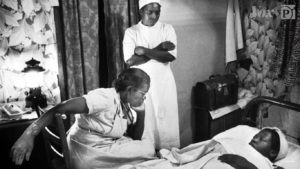Most Drugs Aren’t Tested on Pregnant Women. This Anti-Nausea Cure Shows Why That’s a Problem.
For years, Zofran was the most popular morning-sickness medication in the U.S. Now it’s being blamed for causing birth defects. The larger issue is a drug-safety system that excludes women from clinical trials, potentially putting them and their babies at risk. Chriggy / CC BY-NC-ND 2.0
1
2
Chriggy / CC BY-NC-ND 2.0
1
2
Marquita Smiley’s first surprise was discovering she was pregnant. Her second was how miserable being pregnant felt. With her older daughter, she had experienced some mild queasiness. This time, the nausea and vomiting were so bad, “I would be calling off work and not wanting to get out of bed.” As a single mom in Birmingham, Alabama, and a social worker who investigated horrific cases of child abuse, she didn’t have that option. Her ob/gyn wrote a prescription for Zofran, generic name ondansetron, which had been developed for cancer patients ravaged by radiation and chemotherapy but had become the preferred treatment for extreme morning sickness. The pills melted in Smiley’s mouth, dissolving the nausea with them. “I felt so much better,” she said. “So we just kept kinda going with it.”
Fifty to 90 percent of women spend some part of their early pregnancies sick to their stomachs, and what begins as simple nausea can become dangerously debilitating. Some expectant women use ondansetron for only a few days; Smiley took it two or three times a week into her second trimester. In her fifth month, an ultrasound showed that the left side of her baby’s heart was critically underdeveloped. Three days after her son, Zaidan, was born in April 2014, cardiologists at the University of Alabama Hospital in Birmingham performed open-heart surgery, but a blood clot caused the baby to have a heart attack and his kidneys began to fail. Somehow Zaidan hung on: At two months, he had a heart transplant; at four months, he went home.
Smiley was torn between feeling extraordinarily lucky — Zaidan was her “miracle baby” — and blaming herself for his suffering. As his first birthday neared, one of her coworkers mentioned she’d seen TV commercials by a law firm claiming that Zofran might cause serious congenital heart problems and other birth defects.
Smiley began doing her own research. She had assumed that medications prescribed in pregnancy are tested and monitored for prenatal use, perhaps even more carefully than other drugs. But ondansetron, for years the most widely used drug to treat the most common complication of pregnancy, was never approved in the U.S. or anywhere for use in pregnancy. The pharmaceutical giant GlaxoSmithKline vigorously denies Zofran causes birth defects, and most research so far seems to support that claim. Smiley acknowledges she can’t be certain what caused Zaidan’s problems. But if she’d known the drug hadn’t been approved for prenatal use, she said one morning in her lawyer’s office, distracting her squirmy toddler with Goldfish crackers, “I would not have placed him at risk.”
Women, Drugs and Devices
5 cases that shook the FDA
Thalidomide
How it was used: As a sedative and sleeping pill, off-label for morning sickness
What happened: Developed in West Germany in the 1950s, the drug was soon linked to miscarriages and devastating birth defects, including limb deformities. At least 10,000 “thalidomide babies” were born around the world before the drug was banned in the early 1960s. The US escaped largely unscathed thanks to FDA medical officer Dr. Frances Oldham Kelsey, who refused to approve the drug without sufficient safety information.
The aftermath: Spurred by the crisis, the US government passed amendments in 1962 that require drug manufacturers to prove their products not only safe but effective, too. Thalidomide later re-emerged as a treatment for leprosy.
Diethylstilbestrol (DES)
How it was used: Introduced in 1938 as the first synthetic form of estrogen, it was prescribed to prevent miscarriage, premature labor and related pregnancy complications—even though clinical trials in the 1950s showed it was ineffective.
What happened: In 1971, medical studies found that women exposed to DES in utero (“DES daughters”) were at heightened risk for developing clear cell ardenocarcinoma, a rare vaginal cancer. The FDA warned against its use, but by then, up to 10 million women and children had been exposed.
The aftermath: Women who took the drug have a heightened risk of breast cancer, as do their daughters (who also have higher rates of infertility, pregnancy complications and reproductive abnormalities). DES sons are at higher risk for non-cancerous testicular growths. Thousands of lawsuits have been filed, totaling billions of dollars.
Bendectin
How it was used: A combination of the antihistamine doxylamine and vitamin B6, it was approved to treat morning sickness in 1956
What happened: Close to 33 million women worldwide took Bendectin over nearly three decades. But after families started suing for alleged birth defects in the 1970s, the manufacturer’s insurance premiums soared, and Merrell Dow voluntarily withdrew the drug in 1983.
The aftermath: In the wake of the lawsuits, Bendectin became one of the most-studied drugs in pregnancy. The combination of doxylamine/vitamin B6 was found to be safe, and in 2013, the same basic formula, renamed Diclegis, won FDA approval once more. Bendectin’s most important impact, though, may be in the courtroom: In 1993, in a case called Daubert v. Merrell Dow, the U.S. Supreme Court issued sweeping limits on expert witnesses and “junk science” that affected many areas of the law.
Dalkon Shield
How it was used: Long-acting, reversible birth control that was supposed to be safer than the Pill
What happened: Introduced in 1971, the intrauterine device was used by more than 2 million women in the US and 4.5 million worldwide. But design flaws made its users susceptible to acute pelvic infections and spontaneous abortions, leading to hysterectomies and at least 18 reported deaths.
The aftermath: Manufacturer A.H. Robins suspended sales in 1974 under pressure from the FDA, but didn’t recall the device, leaving thousands of women at risk. Robins eventually declared bankruptcy, 300,000 women filed claims, and lawyers hammered out a $3 billion settlement. The disaster fueled efforts to better regulate the medical device industry. It also discouraged a generation of women from using IUDs.
Terbutaline
How it was used: Approved by the FDA to treat asthma, bronchitis and other lung diseases, it was used off-label to stop premature labor, even though studies eventually concluded it was ineffective.
What happened: In 2011, the FDA warned there was a risk of heart problems and even death for pregnant patients who were administered certain forms of terbutaline over an extended period (longer than two to three days). The agency said it had received reports of 16 deaths and 12 serious heart issues associated with prolonged use of the drug.
The aftermath: It’s still being used for to prevent preterm birth, but in much more controlled settings (i.e., not at home).
Source: Delphine D’Amora, Mother Jones
A healthy baby is the universal goal of pregnancy, shared by women and doctors, researchers and regulators alike. The nine months from conception to birth are extraordinarily dynamic and complex, and the complications that arise can have lifelong effects. There’s a critical need for knowledge about almost everything, from environmental causes of birth defects to how the mother’s preexisting medical conditions can affect her baby’s well-being.
Yet the same desire to protect the fetus often deters scientists and drug makers from studying the expectant mother. When it comes to drug safety, pregnancy is a largely research-free zone, women’s health experts say. The consequence? Treatment that often is based on informed guesswork rather than solid evidence, in which medications that have never been approved for use during pregnancy, and whose long-term dangers may not be known, become the standard of care. Zofran is a case study in just how problematic this system has become.
Zofran is far from unique — almost every drug prescribed during pregnancy in the U.S. is “off label,” meaning it hasn’t gone through the clinical trials required by the Food and Drug Administration before approving a drug for a specific use in a specific population. Only eight medications are currently approved by the FDA for prenatal use; from 1995 to 2011, the agency OK’d only one pregnancy-related drug. (By contrast, 29 drugs to treat cardiovascular-related conditions have won approval just since 2010.) Pregnant women have become what researchers and ethicists call“therapeutic orphans,” reliant on drugs of uncertain risk, sometimes during the earliest and most vulnerable stages of fetal development.
The problem goes back to efforts to protect women and babies from the kind of severe birth defects and other harm caused by thalidomide and other drugs in the 1960s and ’70s — and pharmaceutical companies from legal liability for those injuries. Decades later, “pregnant women may be the most underrepresented group in the entire clinical research process,” a 2011 report by the National Institutes of Health’s Office of Research on Women’s Health declared. In a 2013 analysis, 95 percent of industry-sponsored clinical drug trials excluded expectant mothers; a mere 1 percent were designed specifically to study them.
Yet according to the Centers for Disease Control, as many as 9 in 10 expectant mothers use medications — for ailments that occur before they even realize they’re pregnant; for complications such as morning sickness, early labor, or gestational diabetes; for chronic conditions such as epilepsy, high blood pressure, or depression that often become more challenging to manage as the months pass. Hampered by a lack of peer-reviewed evidence and hard data, ob/gyns find themselves in the dark about some basic best practices: How does a drug work in an expectant woman’s body? What’s the right dose to take and the right time to take it? What are the true risks to the fetus (or lack thereof)? “Pregnant women are not like non-pregnant people,” observed Susan Wood, director of the FDA’s Office of Women’s Health from 2000 to 2005 and now an associate professor of health policy at George Washington University. “They have a different fluid volume ratio, a different metabolism … all sorts of [physiological] changes that could affect how well a drug works.”
Fewer than 10 percent of medications have enough information to determine their safety for prenatal use, the CDC notes. Off-label use of a drug during pregnancy thus becomes a kind of unregulated, unmonitored clinical trial. “We learn on the backs of [pregnant] women while pretending we don’t experiment on pregnant women,” said Ruth Faden, director of the Johns Hopkins Berman Institute of Bioethics. “But in fact, we do.” By the time the real risks become apparent, several decades may pass. The watchdog group Public Citizen analyzed how long it can take the FDA to issue a “black box” warning after problems surface with a drug. The average: 27 years after the drug was approved.
In the absence of reliable information, sometimes mothers-to-be and their physicians conclude the risks are too great and stop a medication that’s really needed, triggering an avoidable medical emergency that can do more harm than the drug itself. “If research is important to tell us when medications are unsafe, it is also important to reassure us when drugs are safe,” Faden and a group of women’s health advocates calling themselves the Second Wave Initiative argued in a recent manifesto.
The question of how to improve research on pregnant women has greater urgency as new threats such as the opioid epidemic and the Zika virus have emerged. As policy makers, medical organizations and women’s health experts grapple for a solution, the most intractable problem may be a deep-rooted cultural bias that elevates the fetus above all else. “There’s been a dogma in which pregnant women come last,” Faden said. “Always last.”
Your support matters…Independent journalism is under threat and overshadowed by heavily funded mainstream media.
You can help level the playing field. Become a member.
Your tax-deductible contribution keeps us digging beneath the headlines to give you thought-provoking, investigative reporting and analysis that unearths what's really happening- without compromise.
Give today to support our courageous, independent journalists.






You need to be a supporter to comment.
There are currently no responses to this article.
Be the first to respond.